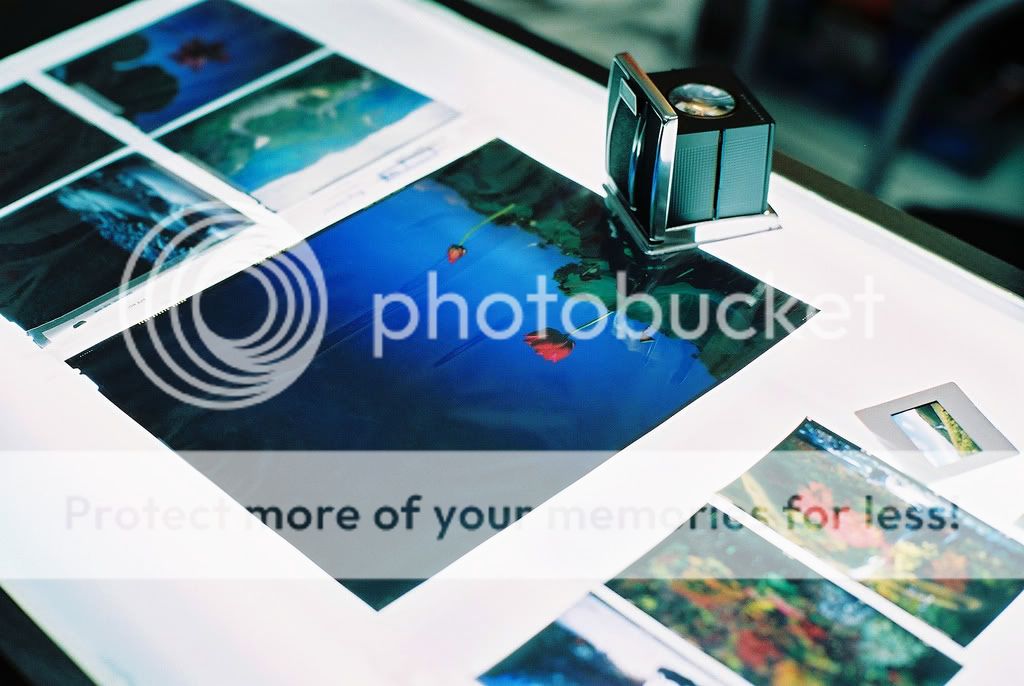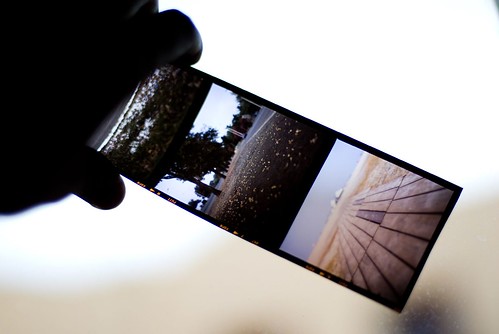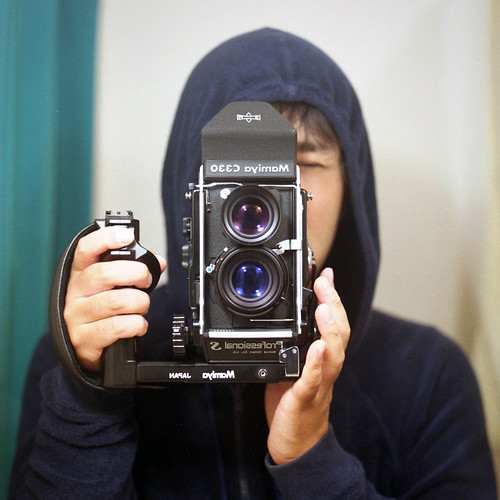Film has of course been almost entirely replaced by digital. I own a half-dozen 35mm film cameras and have doubted I will ever use them again. For a while I thought it would be fun to set up a wet darkroom to develop and print b&w film. But although developing film is easy, darkroom printing is a difficult and mysterious art. Lifetimes are spent mastering the craft. And every experiment costs you money. This is why most people who still shoot film scan it and print digitally. Easier, cheaper, and generally better results. And even a shoot-to-scan workflow makes little sense, unless you are going after a certain film look, since it's a major expense and hassle. Sheesh, just shoot digital and be done.
But lately I've been looking at film from another perspective, valuing a different outcome. Most film uses a negative emulsion (whence, "negatives"), with reversed colors and tones. They are "unreversed" when enlarged and made into prints. Most film is negative film because it's easy to shoot (wide exposure tolerances) and easy/cheap to print.
But there is also positive, or transparency film. Transparencies are also sometimes called slides or chromes (from Kodachrome). These are not normally made to print but to project or scan. Set on a lightbox, they kind of look like luminous little prints but differ from prints in two respects. The resolution of the image is much, much higher, with very dense and fine detail. And also, because the image is projected with transmitted light (through the back) rather than using reflected light (like a print), colors and tones are much more vivid and the light in the picture looks luscious and syrupy. A lot of photographers regard chromes, even apart from the images they reproduce, as art objects.

6x6 chrome of a 35mm chrome
Some artists have taken transparencies to the next level by producing huge, even life-size transparencies, which they mount on light boxes for display. The first and most famous "luminist" is Jeff Wall, who started doing it in the late 70s. At the time it must have blown viewers away, and still they are very impressive. But today we're probably a little jaded to the beauty of transparencies because we're very used to viewing transmitted-light images. That's what computer monitors produce, even if at a fraction the resolution of chromes.

From left: 4x5, 8x10, 35mm (upper right), 6x12cm (?) (lower right)
Most people my age (40+) have probably seen 35mm film slides and I doubt it took your breath away. Too small. But I've seen large format 8"x10" transparencies, and they are stunning. Unfortunately, they take a giant view camera to expose and each exposure will cost you about $20 in film and developing. 4"x5" transparencies are also pretty impressive, but still cost about $6-7 a shot.
But medium format 6x6cm film isn't so bad, about $1.80 a shot. I could almost afford that, and I think the transparencies are just large enough to enjoy even without a magnifying loupe. 6x6 film is about 3.6x larger than 35mm. Still a bit smallish, but far less squinting required.

6x6 chromes
As I said, I have a number of 35mm cameras, but also one medium format, a Mamiya C3. It's a massive twin lens reflex (TLR) camera that my dad gave me. All TLRs are substantial, but this one's a real brick. If you drop it, don't worry about the camera, but look out for your toes. I've never used it, but I'm sure dad paid quite a lot for it, back in the day. I think it will need a service before it is ready for action, but it will certainly shoot 6x6 chromes just fine.
But $100 for the service, $30 for a cheapo light meter, then film and developing. Yeah, that first roll won't be cheap.

But lately I've been looking at film from another perspective, valuing a different outcome. Most film uses a negative emulsion (whence, "negatives"), with reversed colors and tones. They are "unreversed" when enlarged and made into prints. Most film is negative film because it's easy to shoot (wide exposure tolerances) and easy/cheap to print.
But there is also positive, or transparency film. Transparencies are also sometimes called slides or chromes (from Kodachrome). These are not normally made to print but to project or scan. Set on a lightbox, they kind of look like luminous little prints but differ from prints in two respects. The resolution of the image is much, much higher, with very dense and fine detail. And also, because the image is projected with transmitted light (through the back) rather than using reflected light (like a print), colors and tones are much more vivid and the light in the picture looks luscious and syrupy. A lot of photographers regard chromes, even apart from the images they reproduce, as art objects.

6x6 chrome of a 35mm chrome
Some artists have taken transparencies to the next level by producing huge, even life-size transparencies, which they mount on light boxes for display. The first and most famous "luminist" is Jeff Wall, who started doing it in the late 70s. At the time it must have blown viewers away, and still they are very impressive. But today we're probably a little jaded to the beauty of transparencies because we're very used to viewing transmitted-light images. That's what computer monitors produce, even if at a fraction the resolution of chromes.

From left: 4x5, 8x10, 35mm (upper right), 6x12cm (?) (lower right)
Most people my age (40+) have probably seen 35mm film slides and I doubt it took your breath away. Too small. But I've seen large format 8"x10" transparencies, and they are stunning. Unfortunately, they take a giant view camera to expose and each exposure will cost you about $20 in film and developing. 4"x5" transparencies are also pretty impressive, but still cost about $6-7 a shot.
But medium format 6x6cm film isn't so bad, about $1.80 a shot. I could almost afford that, and I think the transparencies are just large enough to enjoy even without a magnifying loupe. 6x6 film is about 3.6x larger than 35mm. Still a bit smallish, but far less squinting required.

6x6 chromes
As I said, I have a number of 35mm cameras, but also one medium format, a Mamiya C3. It's a massive twin lens reflex (TLR) camera that my dad gave me. All TLRs are substantial, but this one's a real brick. If you drop it, don't worry about the camera, but look out for your toes. I've never used it, but I'm sure dad paid quite a lot for it, back in the day. I think it will need a service before it is ready for action, but it will certainly shoot 6x6 chromes just fine.
But $100 for the service, $30 for a cheapo light meter, then film and developing. Yeah, that first roll won't be cheap.

No comments:
Post a Comment